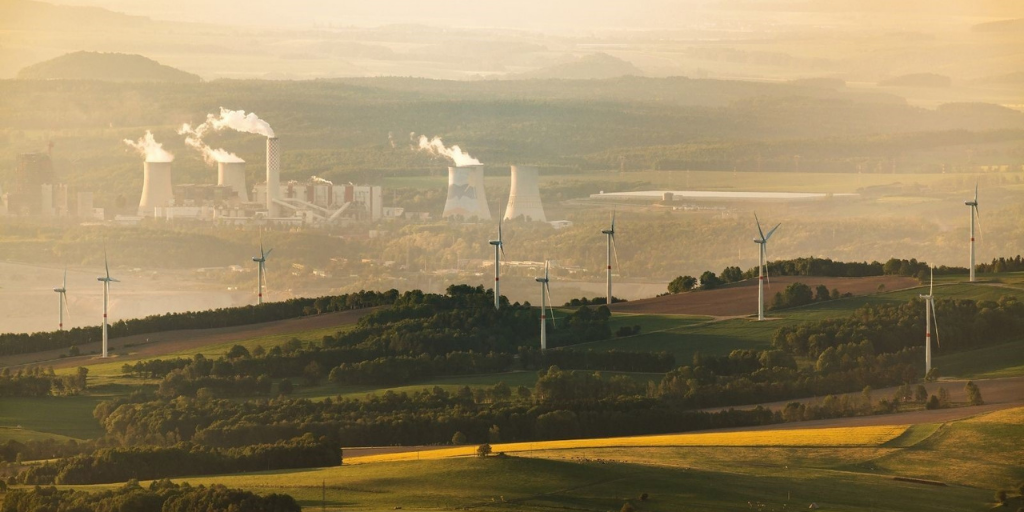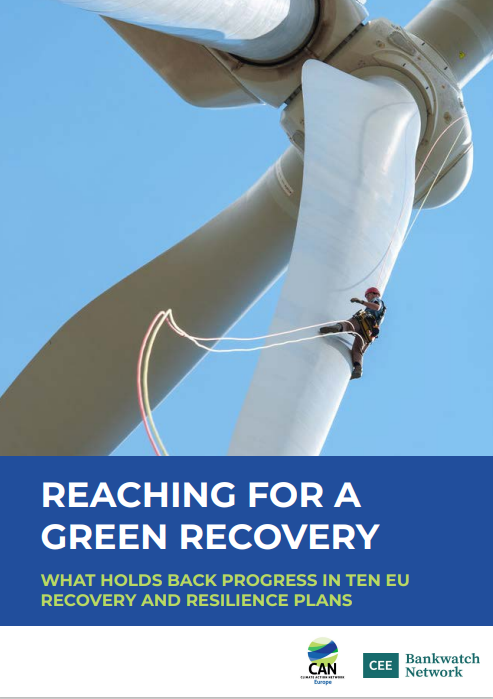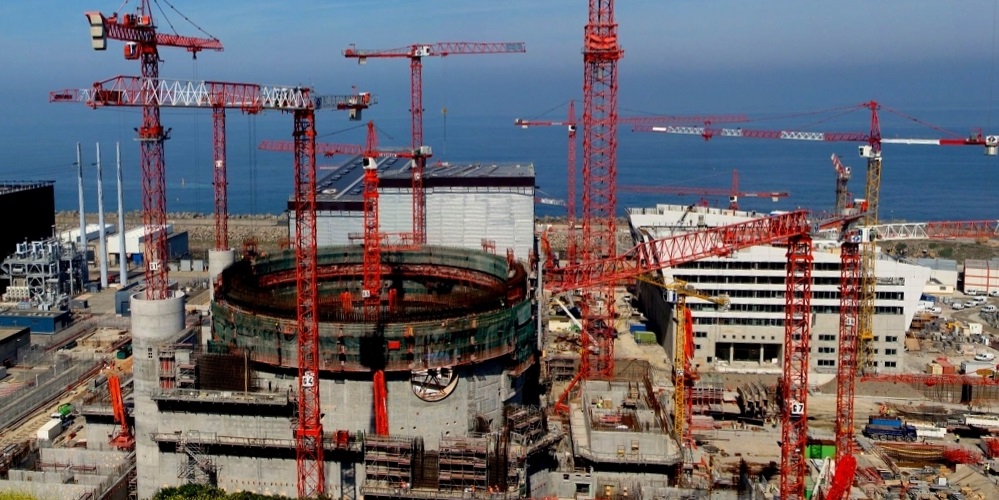Recovery and cohesion policy funds are crucial for driving the energy transition, while promoting renewable energy, energy efficiency, infrastructure development, and innovation. They also play a critical role in reducing regional disparities and creating economic opportunities.
Bankwatch accelerates the impact of EU funding by advocating for transformative and sustainable investments rooted in participatory and transparent processes.

Stay informed
We closely follow international public finance and bring critical updates from the ground.
Key facts
Climate ambition
The European Green Deal and REPowerEU plan both target a minimum 55 per cent reduction in greenhouse gas emissions by 2030 through increased renewable energy, and greater energy efficiency, paving the way for climate neutrality by 2050. However, achieving these ambitious goals requires massive investment in the current and future EU budgets.
Climate spendings
To help Member States recover from the pandemic and meet long-term challenges, the EU is providing unprecedented funding: over EUR 1 trillion in the 2021–2027 budget alongside a EUR 750 billion recovery package. Cohesion policy, representing a third of the EU budget, is a key tool for future-oriented investments, with 30 to 37 per cent allocated to climate action.
Public participation and transparency
Meaningful public participation is critical for a successful just transition. Decisions on the programming and spending of EU funds must be made in a transparent and inclusive way, with the European Code of Conduct on Partnership outlining the rules for engaging citizens in this process.
Key issues
Climate ambition
Central and eastern European countries are facing challenges in meeting the European Green Deal targets, with national energy and climate plans lacking sufficient ambition. Several factors hinder progress, including a lack of political will, fear of economic and social impacts, misconceptions, and resistance to transformative projects, such as those that alleviate energy poverty or empower energy communities. Despite these challenges, positive measures are being implemented in a number of regions across central and eastern Europe, proving that impactful and lasting solutions are possible.
Climate spendings
EU funds are a key source of investment in central and eastern European countries, representing on average over 40 per cent of all public investment, and contributing between 4 and 20 per cent of their gross domestic product. These countries are the primary beneficiaries of cohesion policy funding and the Recovery and Resilience Facility. These funds present a unique opportunity to direct investment towards climate action and social development. To accelerate the fight against climate change, they should be allocated to more impactful, transformative projects. While safeguards like the ‘do no significant harm’ principle are in place to limit harmful investments – such as those supporting fossil fuels – some Member States continue to back problematic projects.
Public participation and transparency
To ensure EU funds effectively address local challenges and needs, meaningful public participation is key. Communities should have access to clear information, be actively involved in designing programmes, and play a central role in monitoring how they are implemented.
Background
Bankwatch closely monitors EU spending in eight countries – Bulgaria, the Czech Republic, Estonia, Hungary, Latvia, Poland, Romania and Slovakia. Since these funds are jointly managed by EU Member States, national governments are responsible for defining measures in line with key standards such as the partnership principle and ‘do no significant harm’.
Bankwatch reviews programme documents, participates in public consultations, and engages with national and local authorities to promote ambitious and effective implementation. We work to ensure that stakeholders have a voice, share timely information, and build capacity so that local communities can fully benefit from EU funding. Our findings are delivered to EU institutions and shared with decision makers to help maximise the impact and potential of these investments.
Cohesion funds – programming period 2021-2027
The current process is the third programming period for Bulgaria. The Partnership Agreement and the operational programmes have not been finalised or approved by the European Commission yet.
EU financing – EUR 10.8 billion
- Some allocations in the transport sector contribute to more sustainable electricity and heating energy supply for the country, ensuring better railway infrastructure.
- The big road projects are highly questionable, as they facilitate the oil dependency of certain sectors of the national economy and can potentially have a serious negative impact on biodiversity.
- The main focus is on the implementation of the projects rather than a significant systematic shift towards a better quality of life and sustainable economy.
Recovery and Resilience Facility
The preparation of the recovery plan was difficult, as it happened during a period of political instability in the country. The real reform commitments were undermined, leading to several serious changes in the priorities and projects. Currently, Bulgaria is on its fifth version of the plan after two rounds of comments from the European Commission.
EU financing – EUR 6.5 billion
- National sectoral strategies do not adequately respond to and are not fully in line with the EU climate priorities and legislative initiatives.
- The lack of a timely implementation of significant reforms in key sectors such as energy and transport has affected the plan’s level of ambition.
- One good improvement in the plan is that the government refused to replace coal with gas in Maritza Iztok, following recommendations from civil society. The construction of a 1 GW steam and gas power plant was proposed, but the idea was abandoned in January 2022.
Cohesion funds – programming period 2021-2027
Both the Partnership Agreement and the operational programmes lack ambition in the area of environment and climate mitigation.
EU financing – EUR 21.1 billion
- Support for the installation of gas boilers and allocation of substantial amounts to gas infrastructure instead of direct electrification can be found in several operational programmes.
- Civil participation and the meaningful involvement of partners is often neglected. Consultations thus far have been too formal and the outcomes were not reported nor properly reflected in the programmes.
Recovery and Resilience Facility
Czechia’s recovery plan achieves a green spending share of 25 per cent, which is below the EU’s benchmark of 37 per cent.
EU financing – EUR 7.85 billion
- The plan will finance the installation of gas boilers for a total amount of EUR 67 million.
- There is not enough money going into the renovation of buildings.
- The participation of civil society in the preparation of the plan was limited: after the initial pressure of non-governmental organisations, some of the proposals were partially reflected in the plan but without any further discussion.
Cohesion funds – programming period 2021-2027
Estonia is using Cohesion Policy funds for accelerating the transition to climate neutrality, but the operational programme includes harmful investments and lacks important policies for energy transformation and ecosystem restoration.
EU financing – EUR 3.5 billion
- Emissions reductions will be hampered by harmful investments in road infrastructure that undermine the shift from road to rail transport. Instead, funds could be used for expanding rail infrastructure and improving urban mobility.
- The demand for building renovation support is very high and the amount foreseen by the government under Cohesion Policy funds is not enough to support the costs.
- With only one activity (wetland restoration) funded by the operational programme, biodiversity remains far too low on the list of priorities for Estonia.
Recovery and Resilience Facility
The recovery plan includes positive and necessary investments but lacks the transformative measures necessary for accelerating the green transition beyond industry and businesses.
EU financing – EUR 862 million
- Promoting the introduction of integrated renewables-based hydrogen technologies might lead to a positive climate impact, but biomass-based hydrogen must not be promoted.
- Estonia is not on track to fulfil the investment level targets set by the EU Biodiversity Strategy 2030, namely to dedicate 7.5 per cent of spending under the EU budget to biodiversity by 2024, and should allocate more towards protecting and restoring biodiversity.
- The interpretation of the ‘do no significant harm’ principle remains unclear in the plan. For instance, the Rail Baltica construction measure is presented as an important component of greening Estonia’s transport system, but as currently planned the project directly threatens important ecosystems and habitats.
Cohesion funds – programming period 2021-2027
The new Partnership Agreement includes the reduction of greenhouse emissions; however, the scale of this is not specified. Allocations set under Cohesion Policy funds in Hungary are not sufficient to cover the actual investment needs.
EU financing – EUR 22 791.1 million
- Cohesion funding covers rather superficial investments in energy efficiency and the deployment of relatively few renewable energy sources, and it fails to promote an ambitious energy transition.
- Biodiversity proofing is not sufficient and biodiversity conservation is a small, separated element among giant projects that aim to boost economic growth.
- Currently 5.66 per cent of the resources aim to conserve biodiversity, and this allocation belongs to only one programme, whereas, by 2026, 10 per cent of Cohesion Policy funds should be dedicated to biodiversity conservation.
Recovery and Resilience Facility
Hungary’s recovery plan, if approved, would achieve a green spending share of 37 per cent and another 13 per cent of the funding might have either a positive or negative impact on the green transition depending on the implementation of the relevant measures.
EU financing – EUR 7.2 billion
- Hungary’s plan misses important opportunities for green transition, for example, it fails to promote the improvement of buildings’ energy efficiency or deep renovation, despite the actual need in the country.
- Less than 0.1 per cent is allocated to biodiversity projects, and there are no guarantees that conservation objectives will be met.
- Nature conservation interests are not represented in the monitoring committee, despite CSOs’ repeated requests.
Cohesion funds – programming period 2021-2027
While the Latvian Partnership Agreement is still not available to the public, the operational programme has already been consulted with civil society.
EU financing – EUR 4.24 billion
- Climate measures do not look promising enough to achieve the planned overall climate goals.
- The operational programme does not make a measurable contribution to the renovation of buildings, and deep renovation is not mentioned in the programme.
- Biodiversity remains poorly addressed – although the operational programme includes relevant actions for nature that are compatible with the Biodiversity Strategy for 2030, there are some core nature protections and nature restorations targets that are left behind.
Recovery and Resilience Facility
Latvia’s recovery plan achieves the share of 37 per cent of funds for climate goals. The plan identifies three main areas for reforms and investments: reducing greenhouse gas emissions in the transport sector, increasing energy efficiency and adapting to climate change.
EU financing – EUR 1.82 billion
- Based on the fact that there is energy poverty in the country, the planned investments that are aimed at improving private and public energy efficiency measures should be higher than those allocated to the transport sector.
- Complementary investments in research and innovation are also envisaged under the climate component, where support will be directed towards research and product development aimed at achieving the EU’s Green Deal objectives.
- The realisation of 29 irrigation projects may potentially harm biodiversity and should not be included in the plan based on the ‘do no significant harm’ principle.
Cohesion funds – programming period 2021-2027
The Partnership Agreement and the main operational programme in the area of climate and environment lack transformative ambition and repeat the shortcomings from the previous EU budgeting period: they focus on large-scale infrastructure projects rather than investments in green transition.
EU financing – EUR 76.54 billion
- While investments in renewables, energy efficiency or biodiversity are underfunded, significant allocations are earmarked for fossil gas infrastructure development, road construction or river regulation.
- A programme that should be aimed at climate action instead pushes Poland towards fossil gas lock-in.
- Energy communities are not named as a priority project in the programme. They should be supported through the recovery plan, which still awaits approval.
Recovery and Resilience Facility
Poland’s recovery plan has not yet been approved due to concerns about the rule of law, although it had been submitted to the European Commission at the beginning of May 2021. This analysis reflects the latest publicly available version.
EU financing – EUR 58.1 billion
- The available version of the plan raises concerns regarding compliance with the ‘do no significant harm’ principle, low reformative ambitions expressed in milestones, focus on the pace of spending rather than the quality and a large number of fossil gas investments.
- Some potentially harmful investments, like waste incineration, were removed in the course of public consultations, but others, like river regulation, appeared in the version adopted by the government.
- Major changes to the plan are expected as a result of negotiations between the Polish government and the Commission.
Cohesion funds – programming period 2021-2027
Cohesion and recovery funding are tainted by investments in false solutions for a green energy transition.
EU financing – EUR 31 billion
- Renewable district heating is not prioritised and gas is foreseen to replace coal-based heating systems.
- Operational programmes still refer to the old targets from the 2019 national energy and climate plan and not to the newer objectives set within the European Green Deal.
Recovery and Resilience Facility
In Romania, measures supporting climate action account for 41 per cent of the recovery plan’s total allocation.
EU financing – EUR 29.2 billion
- The plan includes some positive measures that target energy efficiency, renewable energy production and the consolidation of the legislative framework for the renewable sector.
- There are investments in fossil gas and hydrogen foreseen, for both energy production and heating sectors, failing to take into consideration their financial and environmental risks as well as the level of technical efficiency of some of the proposed technologies.
- The energy and biodiversity components of the plan receive smaller financial allocations compared to other components.
Cohesion funds – programming period 2021-2027
The operational programme does not yet create the incentives for energy savings and decarbonisation needed for carbon neutrality in Slovakia.
EU financing – EUR 12.6 billion
- There is a high probability that the ease and pace of spending will be prioritised over support for the highest greenhouse gas savings, best available technologies and socially vulnerable households.
- Incentives and indicators should catalyse decarbonisation, and fossil gas and unsustainable biomass solutions should not be supported.
- Fossil gas boilers have been excluded from the Partnership Agreement – subsidies from natural gas boilers have been recently redirected towards monitoring and other measures to improve air quality.
Recovery and Resilience Facility
Although civil society and energy experts call for essential structural reforms for decarbonisation, the Slovak recovery plan does not have a decarbonisation plan that details its pathway to carbon neutrality.
EU financing – EUR 6.5 billion
- The amount of funding dedicated to clean energy deployment in its recovery plan is far too low to reach investment needs for energy efficiency.
- Gas investments are still eligible to receive money from the recovery fund, and Slovakia’s plan directs some of the money towards gas boilers – contrary to the recent exclusion in the Cohesion Policy.
Reaching for a green recovery
The Recovery and Resilience Facility is an important opportunity for EU Member States to accelerate the ‘green transition’, but have they made the most of this fund?
The report Reaching for a green recovery: what holds back progress in ten EU recovery and resilience plans analyses ten final recovery plans. Key investments and reforms in the national recovery plan are assessed from a climate action perspective and the ‘do no significant harm’ principle. Each country section includes recommendations addressed to the Member State and the European Commission.
We have been monitoring recovery plans in central and eastern European countries from the beginning of the process and prepared assessments of draft recovery plans from Estonia, Poland, Slovakia, Romania, Latvia, Czech Republic, Hungary, Bulgaria.
We have also identified a lack of transparency in the process of creating recovery plans.

Citizens’ Observatory for Green Deal Financing
The Citizens’ Observatory for Green Deal Financing advocates at the EU and national levels for more transparency and a just distribution of EU funds. The observatory aims to promote the voices of local communities in seven Member States through a series of workshops, public events, virtual tours, roundtables, reports and other activities.
Export Credit Agencies (ECAs)
Efforts to eliminate international public finance for gas and coal projects in the EU and its neighbouring regions focus also on enhancing transparency and accountability within European Export Credit Agencies (ECAs). This ensures that they align with EU climate priorities and stop supporting fossil fuel investments.

EU funds and biodiversity
Nature is in crisis. 81 per cent of habitats in the EU are in ‘poor condition’, and without swift action this will only become worse. We need systemic and wide-reaching action and investments to tackle biodiversity loss and help restore nature before it is too late. The EU has pledged 120 billion of the EU budget to be earmarked for biodiversity by 2026, offering enormous potential to restore and protect nature, providing this is properly invested. We are therefore campaigning to ensure these public funds work for – not against – nature.

Latest news
The ‘do no significant harm’ principle revisited – lessons from Poland for the next EU budget
Blog entry | 16 December, 2025The ‘do no significant harm’ (DNSH) principle is supposed to prevent EU funds from being invested in projects that harm the environment and undermine climate action. Though the principle is meant to increase awareness of the importance of environmental aspects in EU-funded projects, weak and incoherent implementation has hampered its effectiveness across the EU. Lessons learnt in Poland, the largest beneficiary of EU funds, can help improve the application of the ‘do no significant harm’ principle in the next EU long-term budget.
Read moreWhy the EU budget needs a democratic reset – a Czech civil society perspective
Blog entry | 25 July, 2025As the European Union begins shaping its post-2027 budget – the next multiannual financial framework – the challenges ahead are significant. From accelerating climate change to geopolitical tensions and conflicts, the EU needs a budget that is both responsive and forward-looking. Yet, despite the far-reaching impact these decisions will have on millions of Europeans, the process by which they are made still falls short of being truly democratic.
Read moreA budget aware of the challenges, yet falling short on solutions for a resilient future
Press release | 16 July, 2025Despite bold rhetoric on climate and environmental leadership, the European Commission’s proposal for the next long-term EU budget, published today, falls short of aligning future EU spending with the needs of a climate-neutral EU. It fails to provide a clear, enforceable vision for beneficiaries of EU funds to tackle today’s multiple challenges by directing public funds towards building a more resilient, just, and environmentally sustainable economy.
Read moreRelated publications
Bankwatch’s position on the EU’s 2028–2034 Multiannual Financial Framework proposal
Policy position | 12 December, 2025 | Download PDFOur position paper analyses the European Commission’s proposal for the 2028–2034 Multiannual Financial Framework, highlighting how it falls short of addressing Europe’s urgent investment needs.
One Month Left: Urgent call for ambitious, inclusive, and socially just National Building Renovation Plans
Open letter | 28 November, 2025 | Download PDFBuild Better Lives aims to ensure decent, affordable and energy efficient homes and buildings for all. It brings together nearly 100 social justice, housing, climate, and youth civil society organisations, in a pan-European, people-oriented campaign for a socially just built environment that lifts millions out of energy poverty.
Race to the top: Reform and investment proposals for the Social Climate Plans
Report | 31 October, 2025 | Download PDFEU Member States are now finalising their national social climate plans in order to access the EUR 86.7 billion Social Climate Fund from 1 January 2026.
